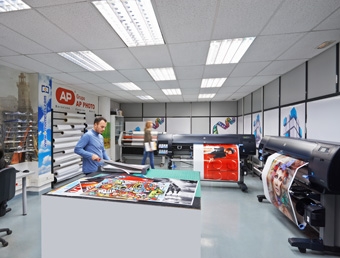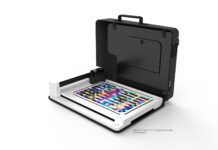Print shops today have evolved and so has the equipment they use. It’s only logical then that color management has become more important than ever and should be a shop’s top consideration.
“One of the biggest challenges most of these people are faced with when it comes to color management is consistency across printers and consistency across the prints,” says John Fulena, vice president of production printing business group at Ricoh Americas Corporation.
Calibration of multiple devices is important. The more consistent your printers are, the more flexibility you have and the more consistent your color can be.
Sandy Gramley, product manager for Latex & Scitex Inks at HP, notes that her company’s Latex 370 has an embedded I-1 spectrophotometer. “It helps the printer be consistent and allows you to calibrate a fleet of printers to be consistent with each other.”
However color can also vary across substrates.
“You can actually calibrate toward one media and then have it print on a separate type of media and have a dramatically different look,” says Fulena, noting that flatbeds can pose a lot more challenges because of the wider variety of substrates one can print on. (Note: Ricoh recently signed an agreement with Mimaki USA to distribute Mimaki JFX200-2513 and Mimaki JFX500-2131 high-performance flatbed inkjet printers designed for high quality and larger output printing.) “That does put some demands on the color management techniques that maybe you might not think about initially.”
In addition, materials all have a different white point, as well as slightly different absorption levels and interaction with the ink. “Having the right print profiles and having the right color management is key for trying to print across multiple devices and multiple technologies,” says Gramley.
What won’t work for color management across devices and prints is “tweaking” the color. “That is a very time-consuming process,” says Gramley. “It can be very frustrating and expensive; you can waste a lot of media doing that.”
These experts agree that it really makes sense to invest in the education and to invest in the software to drive that color consistency.
“If you’re actually working with corporate customers who have corporate colors that you need to hit, who have jobs that are going to be in multiple locations but need to be consistent, or maybe jobs coming off of multiple devices and different technologies that need to be consistent, you really need to invest in software that’s going to help you drive to that consistent color across devices,” advises Gramley.
Of course getting color consistency requires a bit of finesse since there are a lot of standards and profiles. Ricoh has agreements in place with PANTONE, CGS Oris, and some wide format RIP companies. PANTONE is a widely used industry standard that’s been around for years, and it’s a standard everybody wants to try to “hit.”
“You’ve got to be able to match the ink sets to match the colors you’re trying to produce,” warns Fulena, “and I think a lot of people try to match the process colors to the solid colors.”
Fulena advises first setting a standard in your organization—PANTONE, G7, or ICC. “Once you’ve set your standard, find out what your devices do well and what they don’t,” he suggests, “and then formulate a plan on how to maintain and how to calibrate those devices to fit your standard.”
Ricoh offers many solutions to help with color management—advanced classroom training, G7 certification program through IDEA Alliance, on-site visits, Webinars, etc.
Some shops with enough of a business size can even bring in a color expert to help. “This is not the place to skimp because, in the long run, wasted materials and wasted time is much more expensive,” says Gramley.
—Ashley Bray and Jeff Wooten











